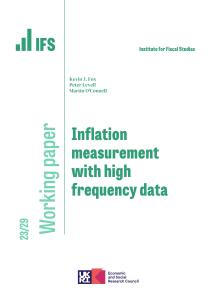It’s an uncomfortable position to be in — horrible, in fact. The present government will preside over the biggest tax rise over a single parliament since at least the end of the Second World War. That will take tax as a fraction of national income to its highest sustained level ever. Yet government debt is stuck at getting on for 100 per cent of national income, public services hardly feel like they are awash with money — to put it mildly — and Jeremy Hunt, the chancellor, has had to promise years of tight spending settlements simply to stop debt heading ever higher.
That’s the “fiscal bind” we wrote about in the Institute for Fiscal Studies’ annual “green budget ” last week. Not only is it a bind faced by this chancellor, it also will set the context for the upcoming election campaign. The upshot is little or no room for manoeuvre on spending unless accompanied by tax rises. However, with taxes already at record levels, tax increases may not look terribly palatable.
So how did we end up in this situation? Surely lots of revenue ought to mean lots of spending?
Part of the answer is that we are spending near-record amounts on debt interest. It’s not simply that we have a lot of debt. In normal circumstances, payments on the stock of debt would be unaffected by what was happening to today’s interest rates. But circumstances are not normal. The Bank of England holds just more than £750 billion of the £2.5 trillion of national debt. Interest payments on that vary immediately with the Bank rate. Of the remainder, about half a trillion is index-linked – so the cost of that depends on inflation.
As a result, while spending on debt interest averaged 2 per cent of national income over the first two decades of the 21st century, it climbed to 4.4 per cent of national income in 2022-23, a figure that had not been exceeded since 1948-49.
Falling inflation will bring that down a bit, but it is still due to settle at well over 3 per cent of national income. That’s more than we spend on any public service, other than the NHS.
A measure of the problem that creates is that later this decade we are due to be running a primary surplus (revenues greater than non-interest spending) for the first time since the turn of the century, but debt still will not be falling as a fraction of national income. In other words, as far as non-interest spending is concerned, fiscal policy that would be extremely tight by the standards of recent decades is still not tight enough if we are concerned about the level of the national debt.
It’s not only interest spending. There are other pressures. Slow growth makes everything harder. Long-term increases in spending on health and pensions can no longer be offset by cuts to defence.
Austerity, surely, has run its course. Indeed, this parliament has seen public spending rising more quickly than usual. Accumulated pressure from decades of demographic change is hitting us at the same time that we have reached the limits to cuts in other areas of spending and, as luck would have it, just as growth, interest rates and global instability are all ranged against us.
Is this all too gloomy? Perhaps we shouldn’t worry about our level of indebtedness or, even if we should, perhaps the forecasts are all too negative and something will turn up and debt will fall? Well, on the second of those, unfortunately more of the risks appear on the downside. Official forecasts assume that fuel duties will rise with inflation. Fat chance. That hasn’t happened in 13 years. Growth prospects have gone downhill since the March forecasts. We are only stabilising debt by cutting investment spending. We may get lucky on growth, but we would be unwise to bet on it.
The other tempting way out of the bind is to worry less about the level of debt. That, effectively, is what chancellors have done for a long time. Whenever forecasts have got worse, they’ve accepted higher borrowing. When they’ve improved, they’ve taken the chance to increase planned spending.
That, alongside the various crises we’ve faced, has led to an upward ratchet on debt. We are paying the price, in that sky-high spending on debt interest is now squeezing everything else. And I’m afraid, in the longer term, everything gets harder still.
We are all by now familiar with the challenges of an ageing population. The NHS workforce plan announced this summer, if implemented, by itself will raise spending by an extraordinary 2 per cent of national income over the next decade or so.
The precise formulation of the present fiscal rule, that debt should be falling in the fifth year of the forecast period, is not sensible: it is easily gamed and not terribly relevant to the longer-term path of debt. However, the intention behind it, that in normal times we need to get debt on a falling path, is correct.
Apart from anything else, as we have seen all too clearly in recent years, we need fiscal firepower in reserve when crises hit. That’s a real constraint.
We can’t define our way out of this pickle. Not by targeting something called “net worth”, as some have suggested, and not by treating so-called preventative spending somehow differently, as others have been pressing for. Changing what we measure? Changing the label won’t change the reality in the markets, which are already demanding much higher payments to hold our debt. They will be the ultimate arbiters — as we saw all too clearly only a year ago.
The bind is a real one. Both we and our political leaders need to face up to it.
This article was first published in The Times and is reproduced here with kind permission.









